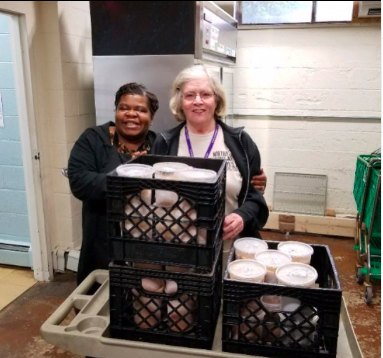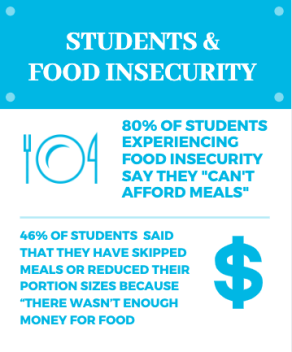Video by Ty Daubert, Aislinn Walsh, and Jason Archer.
“It got really hard when I was 11 because that’s when I noticed that we were food insecure because we were going to food pantries.”
As a child, Daisy Rodriguez, senior political science major, struggled with food insecurity. When she was 9, she moved to the United States from Puerto Rico with her mother and five siblings. In Puerto Rico, her mother worked as a nurse. However, the language barrier made it difficult for her mom to obtain a nursing position.
“We struggled a lot with it because she had to take a lower-paying job…We would depend on breakfast and lunch from school and sometimes our meals,” Rodriguez said. “Like our dinners would be really light and sometimes I would notice that our mom wouldn’t eat as much.”
Daisy’s story is not an anomaly. Currently, 12.3 percent of U.S households are experiencing food insecurity.
The United States Department of Agriculture defines food insecurity as “the limited or uncertain availability of nutritionally adequate and safe foods or limited or uncertain ability to acquire acceptable foods in socially acceptable ways.”
In a country where there is an overabundance of food, the concept of food insecurity can be difficult to fathom.
The issue here is not with food-there is plenty of it, but rather a lack of accessible nutritious food. There is an evident socio-economic disparity concerning food choices in the United States. Typically speaking, healthy foods are more expensive than unhealthy foods.
For example, a hamburger costs $1 at McDonald’s, but a salad costs almost $5. If a family is going to feed their children, it is more cost efficient to pay for the hamburger. The same principle applies to grocery stores. A bag of apples will cost more than two boxes of Kraft mac and cheese. With such a significant price difference, people with lower incomes are faced with a challenging task when food shopping: affording nutritious foods.
No, this doesn’t include the $6 gallon of organic milk or the fancy grass-fed beef because it is “healthier” nor does it include buying boxes of sugary Tastykakes because it is the cheapest item and is loaded with calories.
Rather, it is about affording food that helps the human body grow and flourish.
And thus the issue with food insecurity begins.
Signs of Food Insecurity
Professor Tom O’Donnell is an instructor for the “Food Insecurity” ECG 300 class and currently works for the Environmental Protection Agency.
O’Donnell notes that one of the first signs of food insecurity is worrying about or skipping your meals to save money.
“As soon as you start to worry that is the first indication of food insecurity…,” O’Donnell said. “Then if you say, ‘Oh maybe I’m just going to eat lunch for the next couple of days so I can stretch my money out’… if you are skipping a meal then you are very food insecure.”

On a positive side, food pantries have been of great benefit and use helping those with food insecurity. Food pantries receive unused food donations from regional supermarkets, churches and donors. They allow those struggling with food insecurity to bring food home for free.
Daisy’s family struggled with food insecurity for four years. For the first couple of years, Rodriguez’s family just tried to get by with the food they could afford. When she was 11, her mother started going to the food pantry at her church. That is when she first realized that her family was food insecure.
“It was shocking at first because we came from a really wealthy family when we were in Puerto Rico,“ Rodriguez said. “because my mom had such a stable job.”
During this time, Daisy and her family befriended a lady at the pantry named Ms. Garcia. She would pack Daisy and her sisters’ lunches for school and would invite her family over for Christmas dinners. They still keep in touch today.
When Daisy was 13, her mother joined the army. She also passed the language test, which allowed her to begin working as a nurse. This launched her family into job stability and they were able to become food secure.
Thankfully, Daisy and her family were able to overcome food insecurity within a couple of years.
Unfortunately, for some people, they wage the war with food insecurity for years, even when they are in college.
Food Insecurity on College Campuses
College is the home of the all-you-can-eat buffets, late-night fast-food runs and free pizza at club meetings. Yet, the very existence of food insecurity seems rather hypocritical. How could it possibly exist on a college campus?
O’Donnell notes that food insecurity on college campuses typically affects students who already come from food insecure households.
“Commuters, they don’t have to [get a meal plan], so they come from food insecure households, they’re still commuting,” O’Donnell said. “They’re not on a meal plan, so does their life get better or worse in terms of eating?”
Food insecurity particularly affects but is not limited to, students who commute to school via public transportation. If anything, college just amplifies the food insecurity problem. Students spend hours or more each day commuting on trains or buses. Their days are spent between classes, homework and jobs and then have to commute home. Where are they getting their food if they can’t afford a meal plan?
The Wisconsin HOPE Lab published a study that surveyed 43,000 students at 66 colleges across the country. Their results found that 36 percent of college students are experiencing food insecurity.

An October 2016 study done by Students Against Hunger found that 60 percent of food insecure students said “they couldn’t’ afford balanced meals.”
Even if commuting students do have a 14- or 19-meal plan, it doesn’t cover all of their meals. An additional survey reported that 46 percent of food insecure students who are on a meal plan ran “out of meal points before the end of the term.”
Food insecurity does a lot more to a student than cause hunger, it takes a toll on their academic career.
The Students Against Hunger study also found that “80 percent of respondents reported that their food insecurity affected their class performance.” An additional 53 percent missed a class because of it and 55 percent said that couldn’t buy a textbook.
It is important to note that food insecurity is not something to be ashamed of. Rodriguez adds that it can strike anyone, even those who are employed.
“Most people think that food insecurity happens to people who don’t have a job or just are homeless, but in reality 1 in 4 working-class people are food insecure,” Rodriguez said. “ I know when I went to my pantry there were a lot of people who were… teachers and policeman. Some people do very important jobs, but they are not well paid and sometimes it’s a struggle when you have kids and you have to feed this many persons and your salary is not able to do that.”
Food Pantries On-Campus
As a response to student food insecurity, many college campuses have begun to implement their own food pantries on campus.
As of September 2018, the national College University Food Bank Alliance (CUFBA) had officially registered 686 college campus food pantries. Cabrini University is one of them.
In 2014, Cabrini in conjunction with St. Katherine of Siena Parish established the “Cabrini Cupboard,” an on-campus food pantry for students experiencing food insecurity.
The food pantry is fueled by donations from members of the Cabrini Community and from St. Katherine’s parishioners. The program has grown in popularity over the last two years and now serve over 49 students per year. Recently, it expanded to offer personal hygiene items, such as soaps and shampoos.
Carmel-Jo Madonna, the coordinator for the Cabrini Cupboard, welcomes students who are experiencing food insecurity.
“It’s gotten more and more popular…we encourage students to come in,” Madonna said, “and speak with us so that we know what the needs are”.
Currently experiencing food insecurity?
Students are encouraged to speak with Caramel-Jo Madonna by emailing cmm3284@cabrini.edu or by stopping Student Life Office in Grace Hall, Room 150.
Interested in helping to end food insecurity?
There is a need for quick “to-go” foods and personal hygiene items.
For those interested in donating items to the food pantry, please contact Carmel-Jo Madonna at 610-902-8416 or cm3284@cabrini.edu




